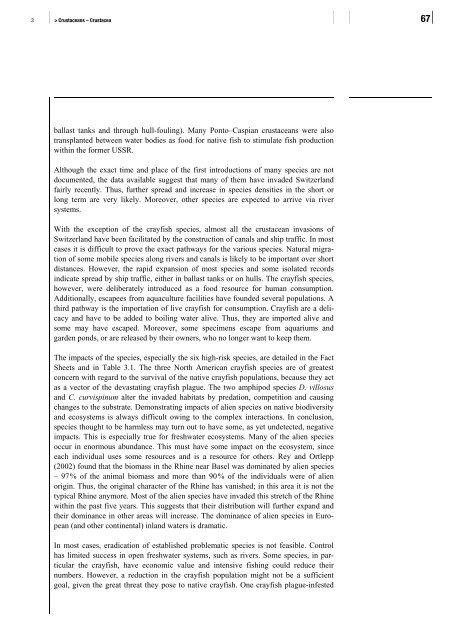Invasive alien species in Switzerland - Schweizer ...
Invasive alien species in Switzerland - Schweizer ...
Invasive alien species in Switzerland - Schweizer ...
You also want an ePaper? Increase the reach of your titles
YUMPU automatically turns print PDFs into web optimized ePapers that Google loves.
3 > Crustaceans – Crustacea 67<br />
ballast tanks and through hull-foul<strong>in</strong>g). Many Ponto–Caspian crustaceans were also<br />
transplanted between water bodies as food for native fish to stimulate fish production<br />
with<strong>in</strong> the former USSR.<br />
Although the exact time and place of the first <strong>in</strong>troductions of many <strong>species</strong> are not<br />
documented, the data available suggest that many of them have <strong>in</strong>vaded <strong>Switzerland</strong><br />
fairly recently. Thus, further spread and <strong>in</strong>crease <strong>in</strong> <strong>species</strong> densities <strong>in</strong> the short or<br />
long term are very likely. Moreover, other <strong>species</strong> are expected to arrive via river<br />
systems.<br />
With the exception of the crayfish <strong>species</strong>, almost all the crustacean <strong>in</strong>vasions of<br />
<strong>Switzerland</strong> have been facilitated by the construction of canals and ship traffic. In most<br />
cases it is difficult to prove the exact pathways for the various <strong>species</strong>. Natural migration<br />
of some mobile <strong>species</strong> along rivers and canals is likely to be important over short<br />
distances. However, the rapid expansion of most <strong>species</strong> and some isolated records<br />
<strong>in</strong>dicate spread by ship traffic, either <strong>in</strong> ballast tanks or on hulls. The crayfish <strong>species</strong>,<br />
however, were deliberately <strong>in</strong>troduced as a food resource for human consumption.<br />
Additionally, escapees from aquaculture facilities have founded several populations. A<br />
third pathway is the importation of live crayfish for consumption. Crayfish are a delicacy<br />
and have to be added to boil<strong>in</strong>g water alive. Thus, they are imported alive and<br />
some may have escaped. Moreover, some specimens escape from aquariums and<br />
garden ponds, or are released by their owners, who no longer want to keep them.<br />
The impacts of the <strong>species</strong>, especially the six high-risk <strong>species</strong>, are detailed <strong>in</strong> the Fact<br />
Sheets and <strong>in</strong> Table 3.1. The three North American crayfish <strong>species</strong> are of greatest<br />
concern with regard to the survival of the native crayfish populations, because they act<br />
as a vector of the devastat<strong>in</strong>g crayfish plague. The two amphipod <strong>species</strong> D. villosus<br />
and C. curvisp<strong>in</strong>um alter the <strong>in</strong>vaded habitats by predation, competition and caus<strong>in</strong>g<br />
changes to the substrate. Demonstrat<strong>in</strong>g impacts of <strong>alien</strong> <strong>species</strong> on native biodiversity<br />
and ecosystems is always difficult ow<strong>in</strong>g to the complex <strong>in</strong>teractions. In conclusion,<br />
<strong>species</strong> thought to be harmless may turn out to have some, as yet undetected, negative<br />
impacts. This is especially true for freshwater ecosystems. Many of the <strong>alien</strong> <strong>species</strong><br />
occur <strong>in</strong> enormous abundance. This must have some impact on the ecosystem, s<strong>in</strong>ce<br />
each <strong>in</strong>dividual uses some resources and is a resource for others. Rey and Ortlepp<br />
(2002) found that the biomass <strong>in</strong> the Rh<strong>in</strong>e near Basel was dom<strong>in</strong>ated by <strong>alien</strong> <strong>species</strong><br />
– 97 % of the animal biomass and more than 90 % of the <strong>in</strong>dividuals were of <strong>alien</strong><br />
orig<strong>in</strong>. Thus, the orig<strong>in</strong>al character of the Rh<strong>in</strong>e has vanished; <strong>in</strong> this area it is not the<br />
typical Rh<strong>in</strong>e anymore. Most of the <strong>alien</strong> <strong>species</strong> have <strong>in</strong>vaded this stretch of the Rh<strong>in</strong>e<br />
with<strong>in</strong> the past five years. This suggests that their distribution will further expand and<br />
their dom<strong>in</strong>ance <strong>in</strong> other areas will <strong>in</strong>crease. The dom<strong>in</strong>ance of <strong>alien</strong> <strong>species</strong> <strong>in</strong> European<br />
(and other cont<strong>in</strong>ental) <strong>in</strong>land waters is dramatic.<br />
In most cases, eradication of established problematic <strong>species</strong> is not feasible. Control<br />
has limited success <strong>in</strong> open freshwater systems, such as rivers. Some <strong>species</strong>, <strong>in</strong> particular<br />
the crayfish, have economic value and <strong>in</strong>tensive fish<strong>in</strong>g could reduce their<br />
numbers. However, a reduction <strong>in</strong> the crayfish population might not be a sufficient<br />
goal, given the great threat they pose to native crayfish. One crayfish plague-<strong>in</strong>fested
















